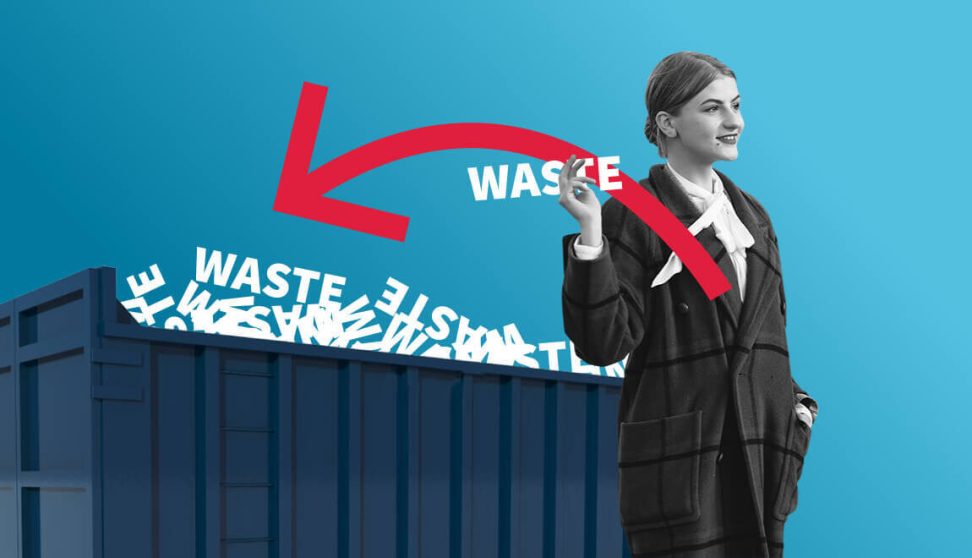7 Wastes of lean – How to eliminate all non-value-added activities?

Every process in business either adds value or creates waste when goods or services are being produced.
The main idea of “lean production” is about highlighting the things that add value by reducing everything else (waste).
As a proven consequence, when you eliminate waste, the quality of products improves, while production time and costs are reduced.
- What is considered as waste in lean production?
- What are the “7 wastes of lean”?
- 1. Transportation – Don’t unnecessarily move products or materials
- 2. Inventory – All the access products and material that are not being processed
- 3. Motion - All movement of equipment not done in the easiest possible way
- 4. Waiting – idle production time where processes are not optimally synchronized
- 5. Overprocessing – Investing more into a product than customer values
- 6. Overproduction – the waste of making too much too soon
- 7. Defects – mistakes and errors that take time to fix
- Other types of waste
- Underutilization
- Waste of resources and materials
- Easy steps to eliminate all 7 wastes of lean
In lean production or, more specifically, the Toyota Production System (TPS), there’s a whole body of knowledge and research on how to reduce waste in business.
TPS offers many different tools for waste reduction, such as Value Stream Mapping, Kanban, and the 5S system.
The Japanese word for waste is muda (wastefulness, uselessness), which relates to muri (overload) and mura (imbalance). All three are the foundation on which the TPS philosophy is built.
Interestingly, in TPS waste is comprehensively categorized into the “7 wastes of lean”, with very concrete recommendations as to how to reduce it. And that’s what you’ll learn in this article.
What is considered as waste in lean production?
We all intuitively know that waste is undesirable, both in business and our personal lives.
In general we can define waste as something unwanted, poor, or bad; something that doesn’t bring anything positive, usually appearing after a specific process has been completed.
In business, a more formal definition would be that waste is all those activities that don’t create any value for the market.
In other words, valuable are all those activities that directly or indirectly lead to an outcome which a customer would be willing to pay for (creating higher added value). Everything else is considered as waste.
It’s important to understand that every organization must also perform activities that do not directly lead to value for customers, but do create value indirectly. That’s why TPS defines two types of Muda:
- Type-1: Necessary non value-adding activities for customers (necessary waste)
- Type-2: Unnecessary non value-adding activities for customers (pure waste)
Reducing or removing Type-1 Muda should only happen after careful analysis and consideration, in order to make sure the reduction won’t impact the quality of the products or overall success of the company.
Nevertheless, the core task of all managers is to optimize efficiency in all value-adding activities and minimize the non-value-adding activities.
With that in mind, research behind “lean production” has shown that even if the products being produced in factories are totally different, the types of waste across industries are very similar. And that brings us to the 7 wastes of lean.
What are the “7 wastes of lean”?
Before we go into the 7 wastes of lean, let’s revise the importance of understanding waste vs. value.
The biggest waste of time, money, energy, passion, and life skills is building or doing something that nobody wants or appreciates.
In business, customers vote how much they value products and services with their money. Building the right things is a prerequisite for business success. That’s not part of lean production deals with, but rather the lean startup concept.
Next to that, when you know what to offer to the market (doing the right things), you want to be as efficient as possible in doing that (doing things right).
Efficiency is about achieving peak performance, where we use the least amount of inputs to achieve the highest output. To minimize inputs, all waste must be eliminated.
In terms of production efficiency, there are seven types of waste:
- Transportation
- Inventory
- Motion
- Waiting
- Overprocessing
- Overproduction
- Defects
You can use the acronym ‘TIMWOOD’ to remember the 7 Wastes of Lean easier.
Using a good time & attendance system and project time tracker and similar technologies supporting business processes can greatly help to reduce different types of waste listed above, especially those that are connected to time waste.
Wasting time is one of the biggest wastes there is.
And now let’s look systematically at each one, as well as some ideas on how to eliminate waste and achieve the maximum possible efficiency in the process of production.
1. Transportation – Don’t unnecessarily move products or materials
Unnecessary transportation is an obvious waste which is easy to notice. Transportation is defined for this purpose as the movement of products or materials from one location to other, the obvious thing being that transportation adds no value to the product.
In lean production, what we consider a transportation waste is when we are moving products that don't need to undergo any processing. In addition to producing waste, every time a product is transported, it is at risk of being damaged, lost or delayed.
The longer the product moves around, the longer it goes without any value being added to it. Handling of the products is also part of transportation waste.
Transportation waste is most often caused by:
- Having several production or storage locations
- Poorly laid out production lines
- Overly-complex production processes
- Large batch sizes
The solution: you have to minimize all transportation in the production process and avoid any unnecessary steps between any two processes. There must be a good flow between the processes, and strict limitation of work in progress.
2. Inventory – All the access products and material that are not being processed
Inventory or inventories are all the components, works in process, and finished products not being processed. Every piece of raw material, all finished goods, and every other item not being sold is actually a cost for a company.
Additionally, inventory is a cost because it has to be stored, and transported, and sometimes needs packaging. It can also be damaged.
Inventory waste might also be cash not used to generate income, space not completely utilized, paperwork which is unnecessarily stored, etc. The most frequent cause of excessive inventory is:
- Overproduction of goods
- Overspending on inputs
- Inventory defects
The solution: Don’t store any extra inventory. Make purchases only when needed and in quantities that are actually required.
3. Motion - All movement of equipment not done in the easiest possible way
The waste of motion includes all movements that are not done as simply as possible. It’s similar to the transportation of products, but movement refers to the motion of equipment and operators.
We are talking here about people or equipment moving or walking more than is required to perform processing.
All excessive motion represents big stress. In business, there is a saying that even machines wear out. You want to save as much energy and resources as possible, even at the micro level.
Examples of motion waste in business are:
- Non-ergonomic office layouts
- Walking to deliver paperwork
- Searching for things
- Lifting heavy things etc.
Motion waste usually disrupts the workflow and delays the start of work.
The solution: A good way to reduce motion is to follow the 5S system of organizing a workplace.
Try to simplify and optimize all motion in the production line, placing equipment nearby, providing an ergonomic workspace, and implementing visual signals so things are easy to find.
4. Waiting – idle production time where processes are not optimally synchronized
Waiting, also known as queuing, is another type of waste. It simply means waiting for the next production step or dealing with interruptions of production during a shift change.
When two interdependent processes are not synchronized, idle time is produced, and we have waiting waste. An example of this is waiting for an answer from another department so you can take action, system downtime, or waiting for shared equipment.
Waiting is most often caused by:
- Poor process planning or layouts
- Idle equipment or unplanned downtimes
- Bottle necks
The solution: Optimize and connect all processes in such a way that the waiting time is minimized, and no time is wasted. The work should be standardized and proper production takt time introduced.
5. Overprocessing – Investing more into a product than customer values
Overprocessing means putting more into a product than is valued by the customer. The goal is to do only the level of processing that matches usefulness and necessity.
Similar to motion, this type of waste is very hard to notice and eliminate in business.
An example of overprocessing in production is painting unseen areas. Machines that are overprocessing because the whole process flow is directed through them are also an example of this kind of waste.
In lean, small is beautiful. Overprocessing can also be a result of unnecessary production steps, using older, outdated methods, or not having standard work plans. It can also be caused by slow approval process.
Overprocessing is most often caused by:
- Unnecessary production steps
- Using outdated methods
- A Lack of standardization
- Slow approval process
The solution is to match the level of processing to what the customer wants and is willing to pay for. Don’t do more, and avoid perfectionism in this regard, rather always have the customer in mind before you start to work on any task.
6. Overproduction – the waste of making too much too soon
The sixth type of waste is overproduction, which means producing more, faster than needed, or “making too much too soon”.
It’s the worst of the 7 since it also leads to other kinds of waste and devalues the need for constant improvement.
Overproduction leads to excess inventory, simply because it is production ahead of demand. Overproduction is usually based on the “just in case” mindset.
Many people think that inventory is an asset and has value, but in reality the value is very low or doesn’t even exist.
The most frequent causes of overproduction are:
- Poor forecasts of market demand
- Unpredictable production schedules
- Lack of automation or poor automation
- Long setup times for production
The solution: Switch from the “just in case” mindset to “just in time” production, by considering the overall takt time of a production line.
7. Defects – mistakes and errors that take time to fix
And finally we come to the last and most obvious type of waste – defects.
Every defected item requires repair or replacement, creates additional paperwork, and wastes resources, materials, and time. It can often also lead to loss of customers.
Most often defects are caused by:
- A Lack of standardization
- Inadequate quality control
- Insufficient machinery repair
- Poor communication
- Human errors
It’s better to prevent defects than try to detect them. Examples of defect waste in business are missing information, errors, and client complaints.
The effort accompanying this type of waste consists of inspecting for defects, avoiding mistakes, and fixing defects as fast as possible. Standardizing all work and performing regular detection of abnormalities is the way to go.
Other types of waste
Lean production is primarily directed at removing waste in production factories. But you can quickly find the “synonyms” for every type of waste in any kind of business, even in purely service-based industries.
No business is immune to waste.
For example, in a service-based industry the following could be considered an equivalent to each of the 7 wastes:
- Transportation: multitasking, going on unnecessary business trips …
- Inventory: undelivered articles, code, any other type of output, tools that nobody uses …
- Motion: unnecessary meetings, looking for things in a messy office …
- Waiting: waiting for meetings to start, waiting for other coworkers to deliver, waiting for approvals …
- Over processing: complex solutions to simple problems, doing things manually that can be automated …
- Over production: production articles, code, services that nobody is willing to pay for …
- Defects: bugs, spelling errors, …
And still we are not done yet with the different types of waste. Based on the seven types of waste in TPS, other authors have added a few additional ones:
Underutilization
Underutilization is a waste of talent, and it means failing to make use of the people within an organization. People are the greatest assets by far, and their underutilization is the greatest waste possible.
Every manager should strive towards developing and applying the company’s talents in order to provide as much value as possible for the markets. Make sure you fully utilize your people with a good project time tracker with powerful time use visualization.
Waste of resources and materials
Waste of resources and materials in business is the failure to make efficient use of electricity, gas, water, and other resources.
A waste of resources doesn’t only cost a lot of money, but also has many other downsides, such as negatively affecting the environment and society as a whole.
And just to list a few more:
- Delays
- Duplication
- Unclear communication
- Lack of information
- Lost opportunities
- Equipment breakdowns etc.
Easy steps to eliminate all 7 wastes of lean
There are five steps to eliminating every type of waste, which are:
- See it: Make waste visible
- Recognize it: Be conscious of waste
- Define who is responsible: Be accountable for waste
- Define the size and magnitude: Measure the waste
- Eliminate or reduce the waste
First you have to know what is causing waste. If you have read this blog post this far, you are well aware of the things which are potentially causing waste at your organization.
Now you have to specifically identify the biggest waste that is draining your resources and find out what type it is.
After that you have to decide if it’s only you who is responsible for the waste, or if it also affects other stakeholders in the business. You, of course, have to involve all the affected stakeholders in the process of removing waste.
It’s good to measure the waste, to clearly see the price you are paying, and determine the priority and difficulty of eliminating it.
There are four actions you can take when trying to eliminate waste::
- Delete it / Stop doing it
- Automate it / Reduce it
- Merge it with other activities
- Delegate it / Outsource it (if not part of the core value)
It sounds easier than it is, but when you see the benefits of eliminating waste you get the motivation to do it more and more. Eliminating waste is also part of the Kaizen philosophy in lean production.
Kaizen is a competitive strategy in which all employees work together to create a strong culture of constant improvement, and part of becoming better and better is improving efficiency and eliminating all waste. So, happy cleaning.










